Books
Books

BRICKS FROM THE KILN #5
Andrew Walsh‐Lister, Matthew Stuart
Bricks from the Kiln is a semi-yearly journal and multifarious publishing platform established in mid-2015 to support critically minded and explorative writing on and around art, design and literature. Edited by Matthew Stuart and Andrew Walsh-Lister, the forthcoming issue, number five, begins with a single sentence:
blankets topologies in glistening snow and blood — produces instructional spattering, again and again — coughs up clotted network diagram hairballs of illegibility — parasitically draws on / from Thomas Browne’s quincunx — meets for The Big ROAR tomorrow, yesterday — lifts loud cows off the page, aloud — flips the coin of language, heads or tails? — politely speaks on writing heard yet seen — twists tongues, transliterates and teases — makes contact with ancestral spirits — traverses the foothills of La Marquesa, past and present — is the Spectre at the feast — (re)traces polymorphous concrete poems — dashes, gestures, speaks, breathes, moves, joyness — is, as ever, tentative, incomplete and inconsistent.
Contributions by Helen Marten, Rebecca May Johnson, Johanna Drucker, Louis Lüthi, Daisy Lafarge, Holly Pester, Ursula K. Le Guin, Quinn Latimer, Stefan Themerson, Slavs and Tatars, Ashanti Harris, Catalina Barroso-Luque, Kevin Lotery, Bronac Ferran with Greg Thomas and Astrid Seme with Alex Balgiu.

BFTK #6: Tentative — Incomplete — Inconsistent
Andrew Walsh‐Lister, Matthew Stuart
This instalment of Bricks from the Kiln doubles as issue #6 of the journal and as an exhibition catalogue for the thematic show ‘BFTK#6: Tentative — Incomplete — Inconsistent: A Catalogue of the Disappeared, Destroyed, Lost or Otherwise Inaccessible’. Presenting objects, artworks, artefacts, models, events and animals that no-longer — or never did — exist in physical form, the exhibition explores themes of death, destruction and reincarnation, examining persisting interests in notions of ephemerality and permanence, memory and record, preservation and erasure, creation and reconstruction.
How do we remember and memorialise? How is space given to the unrecorded? How do we experience the out of reach, concealed, unseen, undiscovered? How can the dematerialised be materialised again, through the mediation of writing, image and sound?
THE ALMOST HORSE
Helen Marten
(inside front / back cover)
‘STILL IN ALL HEARTS, IN ALL BELLIES, IN ALL TOES’:
A BELATED REVIEW OF FESTIVAL DE FORT BOYARD
Matthew Stuart & Andrew Walsh-Lister
(pp.6–8)
EDDYSTONE
Rachael Allen
(pp.11–18)
TO MAKE THE STONE STONY
Emily LaBarge
(pp.21–26)
WHEREFORE AM I NOW?
Lucy Mercer
(pp.29–40)
WESTON: THE TOWN THAT WAS, AND THEN WASN’T
Crystal Bennes
(pp.43–52)
NOTES TO ACCOMPANY VIOLENT INNOCENCE (2019)
Will Harris
(pp.55–64)
GHOST, POCKETS, TRACES, NECESSARY CLOUDS
Matthew Stuart
(pp.66–69)
CONNECTIVITY OF TOUCHING
Ali Na & Mindy Seu in conversation
(pp.71–76)
PEARL
Rose Higham-Stainton
(pp.79–84)
NOTES FROM NEW MEXICO
Jennifer Hodgson
(pp.87–98)
THE MOOG OF AHMEDABAD
Paul Purgas
(pp.101–108)
IN WHICH DECIBELLA ESCAPES AUDITION
Sarah Hayden
(pp.111–122)
D.C.B.: A PARTIAL RETROSPECTIVE
Juliet Jacques
(pp.125–136)
PINBALL REMAINS: ON THE PINBALL ISSUE OF THE SITUATIONIST TIMES
Ellef Prestsæter
(pp.139–150)
TOMB III – CADMIUM (2021)
Gilbert Again
(pp.152–154)
NON-DESCRIPT ANIMAL
David Hering
(pp.157–161)
Cover & Bookmark artwork by Helen Marten

Black Revelry: In Honor of ‘The Sugar Shack’
An experiment in book making, which takes up the form of the LP record as a starting point for re-configuring the haptics of the printed book. Presented as a collection of unbound pages inside a gatefold record sleeve, the publication includes a pressed record, as well as written, visual and sonic contributions from scholars, poets, artists, choreographers and DJs.
Through the logic of the detail, each contributor imaginatively (re)produces Ernie Barnes’s iconic painting The Sugar Shack as an archive of personal histories and a universe of intergenerational connections. Held together as an album, it is a performance to be made at home, which invites readers/listeners to feel art’s histories and to be in them with their bodies.
d.a. carter with contributions by Taylor Renée Aldridge; Samiya Bashir; La Marr Jurelle Bruce; DJ Lynnée Denise, Jennifer Harge, Duane Lee Holland, Jr., William H. Mosley, III, Zoé Samudzi, S*an D. Henry-Smith, Melanie Stevens and Phillip B. Williams.

Matt Mullican’s Pure Projection Landscapes
Since the late 1970s Matt Mullican has developed a practice of performing under hypnosis that extends from his investigations into representation and subjective projection, and from his efforts to “enter the image” and embody a fictional character, a body of work that offers an exceptional perspective on repetition and renewal in performance practice.
This book is the outcome of an extensive research project into Mullican’s hypnosis performances, undertaken within the frame of If I Can’t Dance’s Performance in Residence programme with invited researcher Vanessa Desclaux, and a two-day Class of Masters with Mullican on character construction. Desclaux takes up the question of personification in light of her analysis of Mullican’s hypnosis performances. A selection of Mullican’s photographs and works on paper are reproduced in this book.
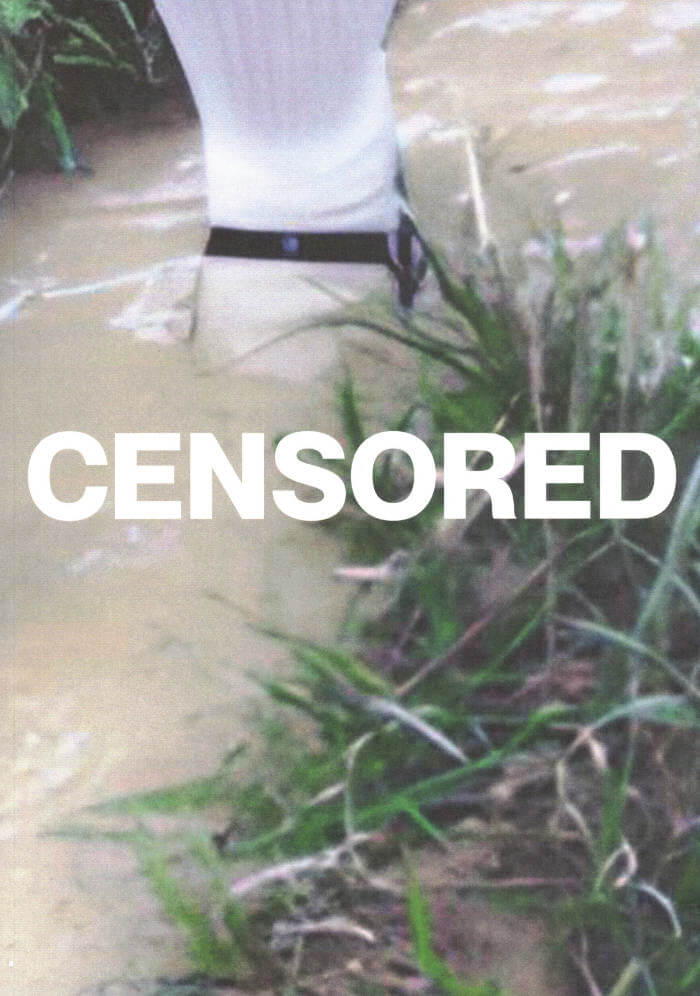
Apocalypticotrashecocidocious - Censored 08
« Apocalypticotrashecocidocious », l’édition Censored 08, parle d’écologie et de luttes anticapitalistes, de vivant et d’humilité
Ses recherches, textes et productions artistiques mènent à une conclusion : l’urgente nécessité de faire front commun pour quitter les logiques d’exploitation hyperviolentes envers la terre, les espèces, les femmes, minorités de genre et personnes racisées. Politiser le rapport que nous entretenons à nos territoires mutilés, qu’ils soient urbains ou ruraux. Comprendre comment le capitalisme s’est érigé en culte quasi religieux fondé sur la dépossession des savoirs, le déracinement des émotions, l’anti-spiritualité et l’individualisme. Il est alors question de militances joyeuses et du refus de la fatalité, de relations inter-espèces, de spiritualités noires, d’écologie au quotidien, de culture white trash et de futurs possibles.
Comment penser l’écologie lorsque c’est notre propre mode d’existence qui parasite le vivant ? Qu’apprendre des mammifères marins ou des espèces invertébrées ? Quels arts, récits et spiritualités pour aller au-delà des imaginaires dystopiques féministes et engendrer l’action ? Comment s’organiser collectivement tout en apprenant à rester à sa place et sans hiérarchiser ?

L'Écriture de Monique Wittig À La Couleur De Sappho
Invitation au voyage à travers l’œuvre littéraire de Monique Wittig, ce livre nous embarque dans une passionnante exploration de ses textes de fiction, de L’opponax à Virgile, non. Il rend compte de la lutte amoureuse qu’elle livre au langage – matériau brut qu’elle travaille au corps pour faire advenir dans la réalité ce qui n’y a pas (encore) droit de cité. La convocation malicieuse et grave des grands récits du passé, les nombreux emprunts aux auteurs anciens, la pratique de la citation font des Guérillères une formidable épopée féministe, du Corps lesbien un Évangile selon Sappho, du Voyage sans fin le combat drôle et tragique d’une Quichotte féministe et lesbienne.
En soulignant la cohérence des textes et leur fragmentation, Catherine Écarnot met en évidence la passion poétique qui habite ces livres que Wittig concevait comme des « chevaux de Troie » : des machines de guerre destinées à fissurer la réalité pour y inscrire une subjectivité mouvante, échappée du continent noir de la féminité, rétive aux assignations de genre. Uniques et radicalement disruptives, les fictions ainsi créées ouvrent grands les chemins qui relient littérature et lesbianisme.
Publié pour la première fois en 2002, cet ouvrage, le premier consacré en Europe à l’œuvre witigienne, reparaît dans une nouvelle édition remaniée, actualisée et enrichie de nombreuses références aux études publiées depuis sa parution.

Art et production
Art et production de Boris Arvatov fait partie des classiques oubliés des avant-gardes qui se sont épanouies durant la Révolution russe. Publié à Moscou en 1926, il vient porter le fer dans les débats qui agitent l’école constructiviste : que doit être le statut de l’art après la révolution, ses liens avec les techniques industrielles de reproduction, avec la critique de la vie quotidienne, comment doit-il entrer dans l’usine ? Autant d’interrogations radicales, témoignages d’une séquence politico-sociale bouillonnante. Une nouvelle conception de l’art émerge, qui laissera une empreinte indélibile sur une tradition de critiques matérialistes de la culture, de Walter Benjamin à Peter Bürger, en passant par Fredric Jameson, celle qui posera la question de l’articulation entre pratique artistique et logiques propres à la sphère de la production. Un document exceptionnel enrichi d’illustrations, paraissant en français pour la première fois, une porte prviliégiée sur un moment-clé de la modernité exthétique du XXe siècle.
Boris Arvatov (1896–1940) est un artiste et critique d’art russe. Il est notamment connu comme théoricien du productivisme, un mouvement d’avant-garde post-révolutionnaire lié au constructivisme.

Logique Du Genre
Qu’est-ce que le genre dans le capitalisme contemporain ? C’est à cette question qu’invite à répondre ce recueil, à partir d’une démarche théorique inspirée du féminisme et du marxisme. Il s’agit de penser, depuis une analyse systématique du rôle joué par le travail domestique et les violences de genre dans notre système économique, un monde au-delà de l’exploitation, et donc du genre et des ses contraintes. Un communisme au présent, qui s’empare de tous ces questionnements, trop souvent ignorés dans l’histoire du mouvement ouvrier.
Jeanne Neton et Maya Gonzalez participent à la revue anglo-américaine Endnotes, dont le présent volume constitue la première traduction française. Elles se placent dans la lignée du féminisme autonome italien (on songe à Silvia Federici, Leopoldina Fortunati ou Mariarosa Dalla Costa) pour proposer une contribution originale et stimulante.
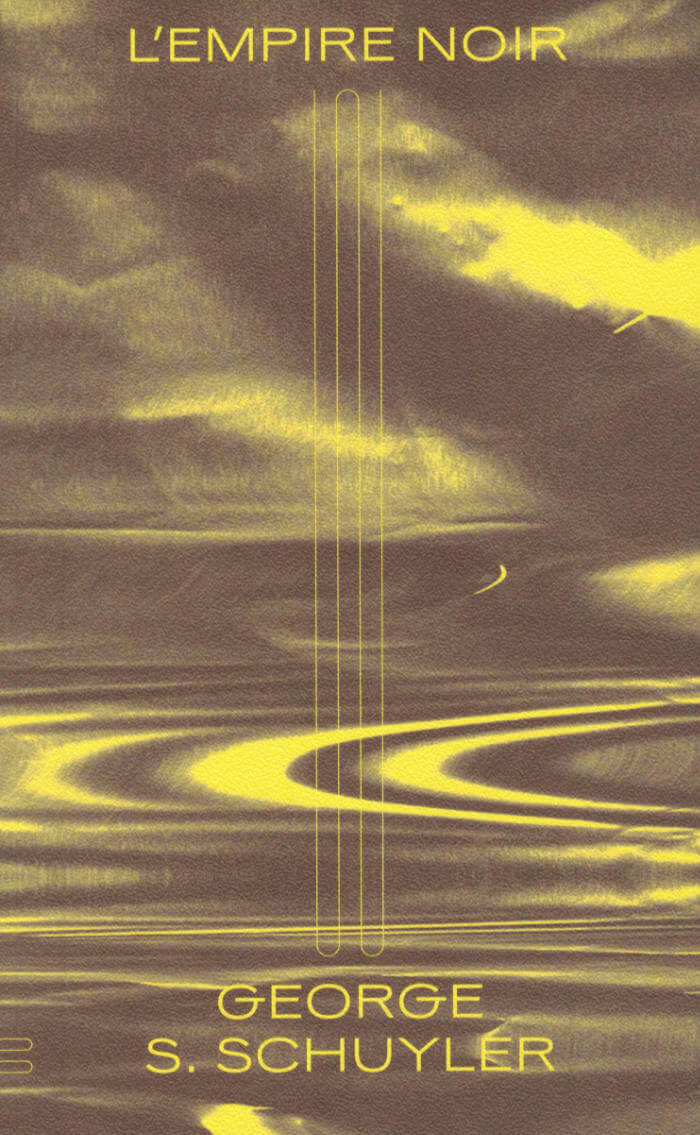
L'Empire Noir
Après une campagne militaire fulgurante, l’organisation secrète du redoutable Dr Belsidus a chassé les puissances occupantes du sol africain et s’est rendue maitre de l’ensemble du continent, unifié pour la première fois en un gigantesque empire. L’expansion a démarré et l’édification d’une civilisation d’un genre inédit est en marche. Mais les nations européennes, après s’être fait la guerre, s’apprêtent à revenir. Une course s’engage entre l’Internationale noire et les appétits impérialistes : sabotages, espionnage, guerre technologique ou bactériologique, les héros et héroïnes de L’Internationale noire né reculeront devant rien pour sauvegarder cette indépendance acquise de haute lutte.
Dans ce second volet du roman-feuilleton qui fit la réputation de G. Schuyler, retrouvez les nouvelles aventures de nos personnages, dorénavant contraints à une lutte géopolitique d’une ampleur inégalée, pour garantir à leur Empire noir un avenir radieux !
George Samuel Schuyler, 1895–1977, fut un essayiste, journaliste et romancier de première importance dans le monde culturel africain-américain de l’entre-deux-guerres. Il reste connu pour la férocité de ses critiques. Il est l’auteur d’un seul roman, Black No More, traduit en France en 2016 et d’un essai romancé dénonçant la traite au Liberia, produit de son enquête de terrain dans le pays. Proche des courants socialistes jusqu’à la Seconde Guerre mondiale, il prendra un virage nettement réactionnaire par la suite, tout en demeurant dans les mémoires de toute une génération d’écrivains, tels qu’Ishmael Reed ou Samuel Delany.

L'Internationale Noire
Années 1930. L’Afrique est sous la férule des puissances impérialistes européennes et la domination blanche s’est étendue à toute la planète. C’est sans compter avec la conspiration tramée par la diabolique Dr Belsidus : son organisation, véritable machine de guerre savamment bâtie grâce aux cerveaux noirs les plus ingénieux, composée d’hommes et de femmes sur tous les continents résolus à mener une lutte sans merci et sans répit, se prépare à changer la face du monde en donnant à l’Histoire un tournant imprévu. Nous voilà embarqués au coeur de l’action avec le journaliste Carl Slater, recrue malgré lui de la redoutable Internationale noire.
Avec ce roman-feuilleton fortement mêlé de science-fiction, George Schuyler, figure éminente de la Harlem Renaissance, explorait dès 1936 les thématiques d’une guerre de libération des peuples de couleur aux dimensions planétaires, et la constitution d’un empire africain. À travers les aventures proprement rocambolesques de ses personnages et l’utilisation de toutes les ficelles du genre, il donna naissance à une satire troublante, un objet littéraire encore non identifié qu’on renconnaîtra plus tard comme un des précurseurs de l’afrofuturisme.
George Samuel Schuyler, 1895–1977, fut un essayiste, journaliste et romancier de première importance dans le monde culturel africain-américain de l’entre-deux-guerres. Il reste connu pour la férocité de ses critiques. Il est l’auteur d’un seul roman, Black No More, traduit en France en 2016 et d’un essai romancé dénonçant la traite au Liberia, produit de son enquête de terrain dans le pays. Proche des courants socialistes jusqu’à la Seconde Guerre mondiale, il prendra un virage nettement réactionnaire par la suite, tout en demeurant dans les mémoires de toute une génération d’écrivains, tels qu’Ishmael Reed ou Samuel Delany.

La Volonté de Changer
Si pour beaucoup d’hommes, le féminisme est une affaire de femmes, bell hooks s’attelle ici à démontrer le contraire. La culture patriarcale, pour fabriquer de « vrais hommes », exige d’eux un sacrifice. Malgré les avantages et le rôle de premier choix dont ils bénéficient, ces derniers doivent se faire violence et violenter leurs proches pour devenir des dominants, mutilant par là-même leur vie affective. La volonté de changer est un des premiers ouvrages féministes à poser clairement la question de la masculinité. En abordant les préoccupations les plus courantes des hommes, de la peur de l’intimité au malheur amoureux, en passant par l’injonction au travail, à la virilité et à la performance sexuelle, bell hooks donne un aperçu saisissant de ce que pourrait être une masculinité libérée, donc féministe.
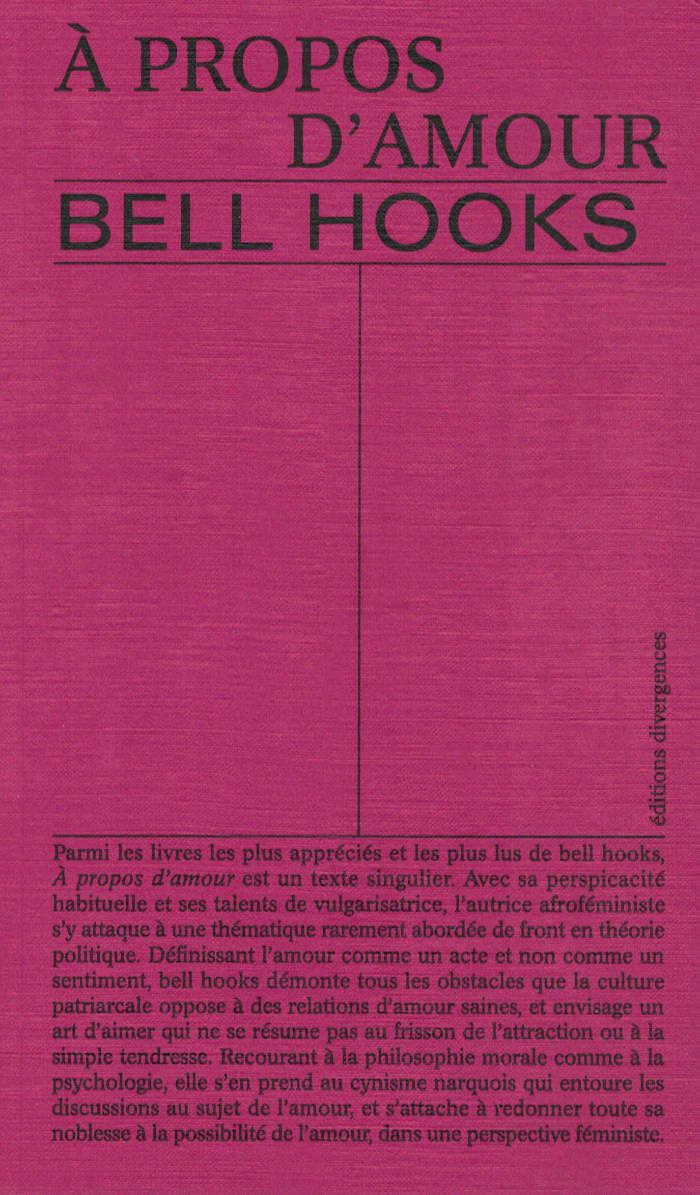
À Propos D'Amour
Parmi les livres les plus appréciés de bell hooks, À propos d’amour est un texte singulier. Avec sa perspicacité habituelle et ses talents de vulgarisatrice, l’autrice afroféministe s’y attaque à une thématique rarement abordée de front en théorie politique. Définissant l’amour comme un acte et non comme un sentiment, bell hooks démonte tous les obstacles que la culture patriarcale oppose à des relations d’amour saines, et envisage un art d’aimer qui ne se résume pas au frisson de l’attraction ou à la simple tendresse. Recourant à la philosophie morale comme à la psychologie, elle s’en prend au cynisme narquois qui entoure les discussions au sujet de l’amour, et s’attache à redonner toute sa noblesse à la possibilité de l’amour, dans une perspective féministe.
GLORIA JEAN WATKINS, connue sous son nom de plume BELL HOOKS, née en 1952, est une intellectuelle, féministe, et militante étasunienne. Elle a publié plus de trente livres et de nombreux articles, et est apparue dans plusieurs films documentaires. Traduits dans de nombreuses langues, ses ouvrages sont considérés parmi les plus importants sur la question aux Etats-Unis et suscitent un réel engouement en France depuis quelques années. Les éditions divergences ont déjà traduit et publié deux de ses ouvrages Tout le monde peut être féministe et La volonté de changer.

Par-Delà Les Frontières Du Corps
Comment reprendre corps ? Comment nous rapporter au corps, cet objet éminemment historique, domestiqué, violenté, pathologisé ? Silvia Federici répond : écoutons le langage du corps, sa fragilité et ses imperfections, afin de retrouver, par-delà ses frontières, la continuité magique qui nous relie aux autres êtres vivants qui peuplent la terre. Mais surtout, identifions la plaie : les rapports sociaux de genre, de classe et de race. Dans cet ouvrage accessible et personnel, en discussion avec les mouvements féministes contemporains, Silvia Federici entreprend d’extirper nos corps des pouvoirs et des dispositifs technologiques qui les aliènent et les transforment. Politiques de l’identité, chirurgie de transformation des corps, nouvelles technologies reproductives, ce livre examine avec lucidité ces questions brûlantes qui traversent le champ féministe.
Traduit de l'anglais par Léa Nicolas-Teboul
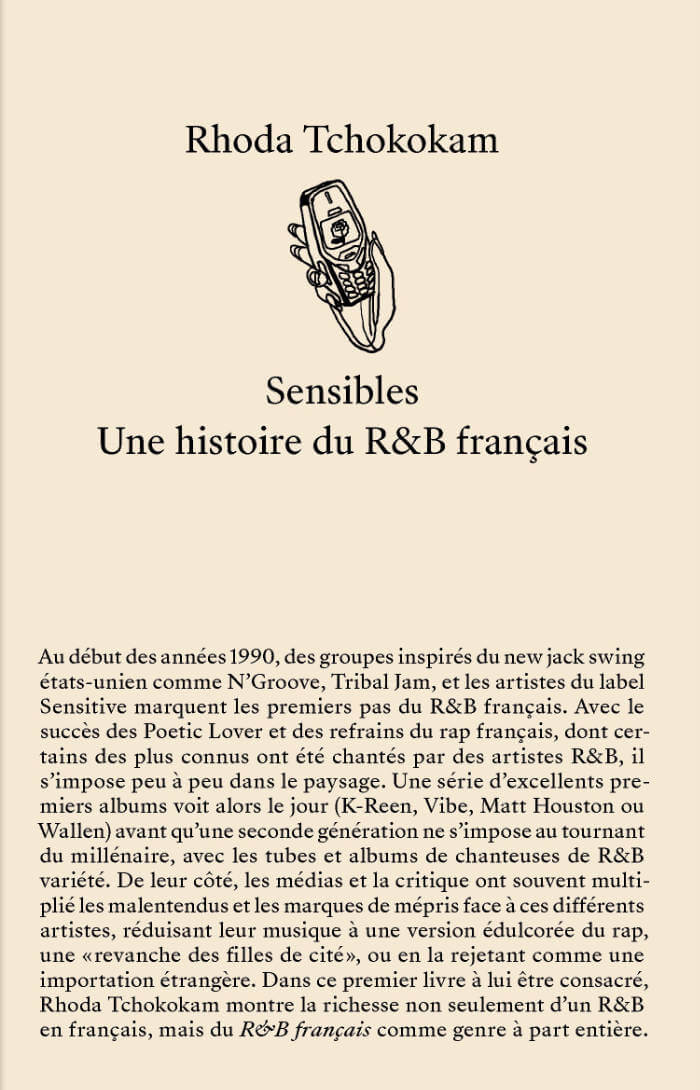
Sensibles : une histoire du R&B français de Rhoda Tchokokam
Au début des années 1990, des groupes inspirés du new jack swing états-unien comme N’Groove, Tribal Jam, et les artistes du label Sensitive marquent les premiers pas du R&B français.
Avec le succès des Poetic Lover et des refrains du rap français, dont certains des plus connus ont été chantés par des artistes R&B, il s’impose peu à peu dans le paysage. Une série d’excellents premiers albums voit alors le jour (K-Reen, Vibe, Matt Houston ou Wallen) avant qu’une seconde génération ne s’impose au tournant du millénaire, avec les tubes et albums de chanteuses de R&B variété. De leur côté, les médias et la critique ont souvent multiplié les malentendus et les marques de mépris face à ces différents artistes, réduisant leur musique à une version édulcorée du rap, une «revanche des filles de cité», ou en la rejetant comme une importation étrangère. Dans ce premier livre à lui être consacré, Rhoda Tchokokam montre la richesse non seulement d’un R&B en français, mais du R&B français comme genre à part entière.
En s’appuyant sur la parole des principales actrices et acteurs de ce mouvement, Rhoda Tchokokam en propose une histoire culturelle ambitieuse. Sa passion pour les chansons de R&B français croise en permanence l’analyse de leur dimension politique : elle examine aussi bien leur manière d’assumer la sexualité que leurs injonctions à la pudeur, les stratégies de formatage commercial que l’affirmation d’une sororité noire dans les clips.
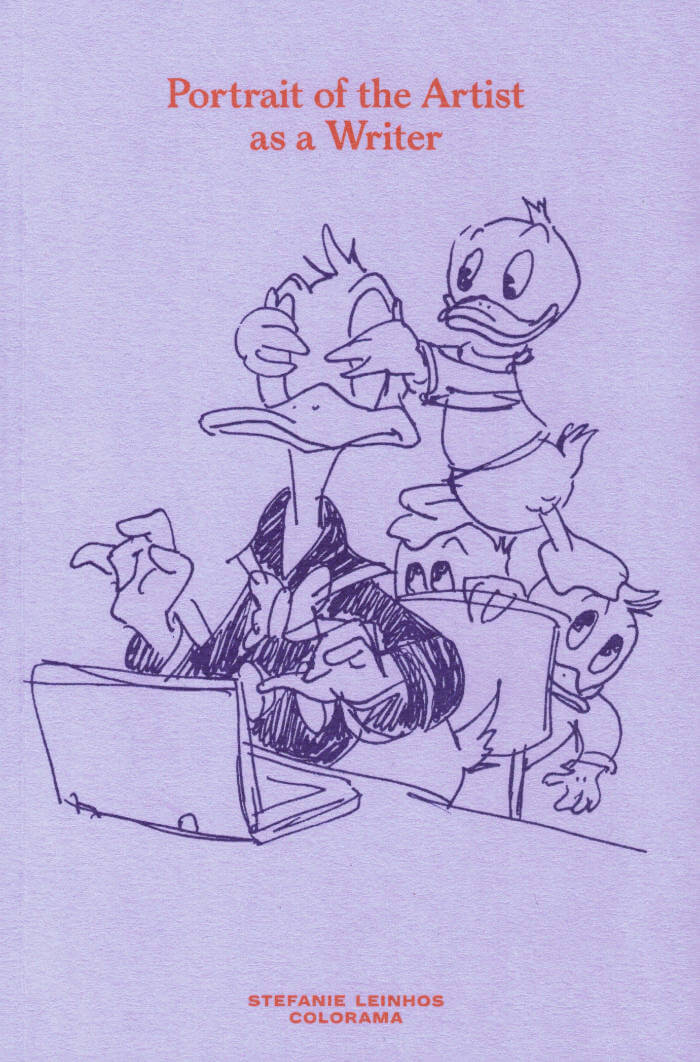
Portrait of the Artist as a Writer
"Portrait of the Artist as a Writer" is a collection of short stories, quotes and drawings about dinosaurs, gay lesbians and how to lose a joke at the lake.
Risoprinted in pumpkin and purple, perfect binding with glue, first edition of 300, Berlin 2022.

Gravity Road: A Rollercoaster Reader
Jesse Darling, Heinrich Dietz and 2 more
Constructed in Pennsylvania in 1827, Gravity Road was a precursor to the modern roller coaster; a sloping stretch of railroad used to cart coal out of mines. With passenger rides on offer soon afterwards, the rapid descent became an attraction and the technology was appropriated for thrill rides in amusement parks.
Jesse Darling’s sculptures, drawings and installations address the fallibility, fungibility and mortality of living beings, systems of government, ideologies and technologies – nothing is too big to fail. For his exhibition at Kunstverein Freiburg in 2020, Darling created a sculpture of a dysfunctional roller coaster, broken down to a child-like scale, becoming an anti-monument to a modernity that celebrates progress, acceleration and mastery and produces violence.
Exploring the entangled history of labour, leisure, extraction and entertainment, Gravity Road: A Rollercoaster Reader was commissioned in response to Darling’s 2020 exhibition, bringing together new texts by artist and Darling-collaborator Joe Highton and writer Sabrina Tarasoff along with a correspondence between Darling and the Kunstverein’s director Heinrich Dietz.
FEATURING TEXTS BY:
Jesse Darling
Heinrich Dietz
Joe Highton
Sabrina Tarasoff
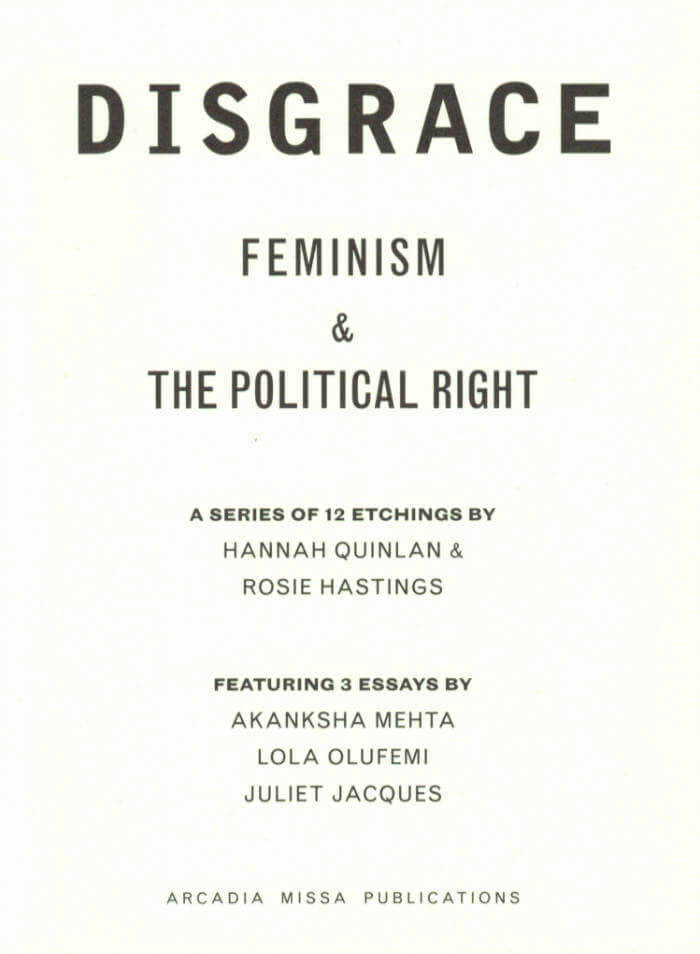
Disgrace: Feminism And The Political Right
Rosie Hastings, Hannah Quinlan
DISGRACE: Feminism and the Political Right explores the history of conservative feminism in the UK from the Edwardian period to today. Expanding on Hannah Quinlan and Rosie Hastings’ research for their eponymous exhibition, the book aims to provide contextual information for the viewer, both as a resource on the history of feminism on the political right and to provide a deeper historical and political insight into the works within the exhibition.
The book centres around a timeline created by 12 etchings, with three essays covering what the artists have identified as three significant time periods, mapping the connections between the various historical manifestations of conservative feminism that lead to the current moment. An essay by Akanksha Mehta, a lecturer in Gender, Sexuality, and Cultural Studies and the co-director of the Centre for Feminist Research at Goldsmiths, considers the nature of the women’s suffrage movement, focusing on the relationship between the suffragettes and eugenics discourse. A polemical text by Lola Olufemi, a black feminist writer and organiser with the London Feminist Library, questions the women’s liberation movement and ‘sex wars’ of the mid 20th century. In the final essay – alongside etchings exploring ‘free-market feminism’, Theresa May’s ‘Women2Win’ campaign and the proliferation of transphobic rhetoric – writer, filmmaker and journalist Juliet Jacques uses Caryl Churchill’s innovative 1982 play ‘Top Girls’ to trace the trajectory of women in power, from Thatcher into the future of feminism.
FEATURING 3 ESSAYS BY:
Akanksha Mehta
Lola Olufemi
Juliet Jacques
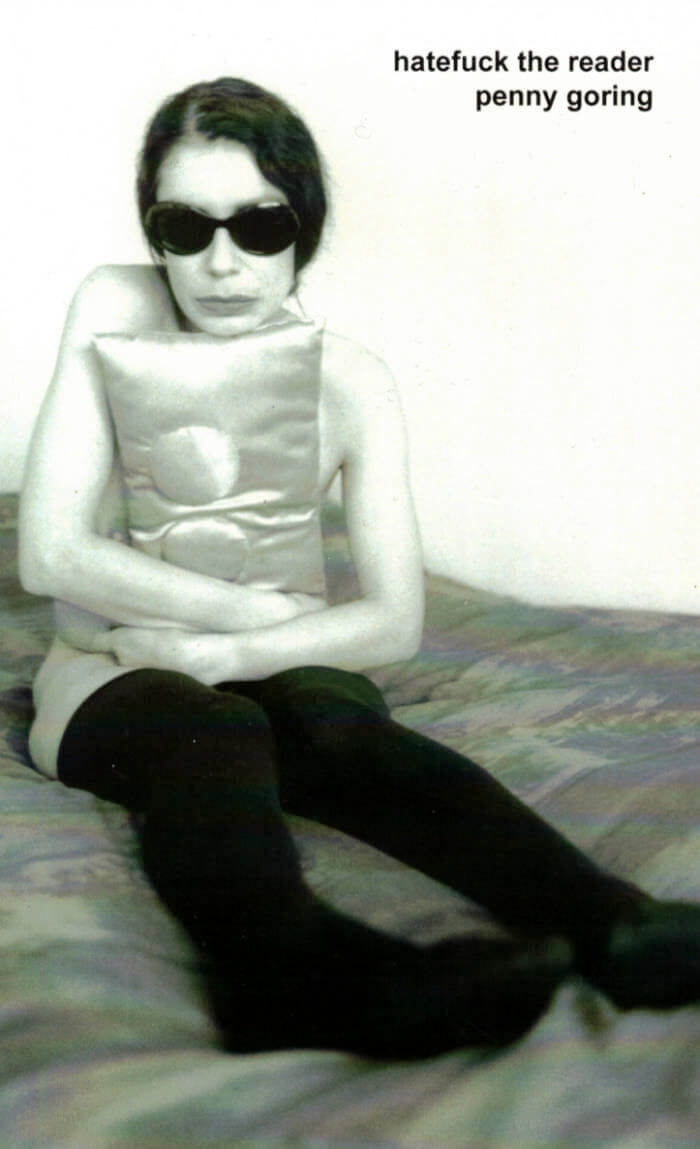
hatefuck the reader
“This book is about damage and violence, about the ramifications of channeling intensity at all costs. It is a text that is utterly compelling, that you tumble into and cannot escape from. I fucking loved it.” — Dodie Bellamy

Fail Like Fire
Fail Like Fire is a carefully selected collection of twenty poems, written over the past HOWEVER MANY years, from Penny Goring’s intensely personal poetry archive.

All Us Girls Have Been Dead for So Long
Kathy Acker’s final published text, Eurydice in the Underworld, harnesses the Greek mythology of the heroic trip to hell; refocusing the story’s centre away from the male hero and onto the dead girl, who has been murdered by a snake.
Katabasis refers both to a journey into the underworld, and a trip to the coast. In times of climate crisis, hell – the realm of the dead, the scorching, the boiling, the rotting – is also situated at the sea, as waters heat, melt and rise.
First performed in 2019 at the ICA, London, All Us Girls Have Been Dead for So Long was a low-fi musical extravaganza flowing between beach and underworld, animating the animal, alien, and abject actors in our current climate apocalypse – most notably Ecco the Dolphin, who has lost their pod and must (like Eurydice, Orpheus and so on) travel deep beneath both time and space to rescue their missing and possibly dead kin.
Only a fool will now attempt to stop us girls. To halt our ecstatic singing.
A play in three acts by Linda Stupart and Carl Gent with a foreword by Isabel Waidner.

Verlag der Buchhandlung Walther König
Where We Meet
This first publication of the artist Melike Kara, emphasises her work of the last two years and thus on a specific body of work that represents a shift in the artist’s methodology.
Her paintings have undergone a change, as they are less figurative and more abstract (although Kara’s abstractions reveal forms here and there).
Some of these forms are reminiscent of limbs, hybrids between bodies and dissolution. Her focus has also changed in terms of subject matter.
It is now less a matter of consciousness, and more about identity and questions of origin. She thus complements, or rather expands, the presentation of these paintings in exhibitions with site-specific installations.
Published after the exhibition, ‘Melike Kara: Where We Meet’ at Jan Kaps, Cologne (4 June – 22 August 2020).
With contributions from Jana Baumann, AnneClaire Schmitz & Fabian Schöneich.

Twenty Terrifying Tales from our Techno Feudal Tomorrow
William Kherbek’s Twenty Tales from our Technofeudal Tomorrow are of course twenty tales from our technofeudal today. From the software company to the art gallery to the prison to the nature park, here is our scary, scary world as seen through the Kherbekian filter: colors pushed to full saturation, soundtrack ramped up to eleven, video played at 1.1x speed. Luckily, the terror of true realism is laced with wild insights, and the acerbic critique is mercifully cut with Kherbek’s signature raucous hilarity.
"Read this book for its political sagacity and wit, but also for its linguistic extravagance, its jubilant play on every word you thought you knew — down to the last punctuation mark. It’s the kind of funny that makes you smack yourself on the forehead. (But as always, as one character reminds, “keep one hand free for rose.”) We can only hope that some CEO does not pick this book up and take it as an instruction manual." – Elvia Wilk, author of Oval
"Kherbek’s ruthless, dystopian future bears an uncanny resemblance to present-day office politics. Twenty Terrifying Tales from Our Technofeudal Tomorrow is a book that, in true Swiftian style, is written “to vex the world rather than divert it.” – Susan Finlay, author of My Other Spruce and Maple Self

Ultralife
Big data (n) is high-volume, high-velocity and/or high-variety information assets that demand cost-effective, innovative forms of information processing that enable enhanced insight, decision making, and process automation.

Ecology of Secrets
Deep cover, a new identity, a beached whale… a man with dreadlock implants using the alias Spanx is rooting the crusty enviro-activists out of their squats.
An ambitious young detective is tasked with creating a new kind of surveillance project to contain domestic extremists: become a domestic extremist. Under the pretence of forming a cell of environmental activists, Spanx and company go deep into the belly of the beast. Along the way, they take over the identities of dead children, the carcasses of cetaceans, and Wordsworth’s cottage in Grasmere. But then Spanx falls for a flower child called Psyche, takes on one identity too many and things really get complicated.
Arcadia Missa Publications, London, 2013; with additional editing by Felix L. Petty.